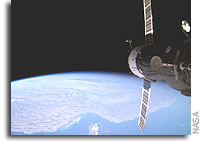NASA Space Station On-Orbit Status 19 July 2005

SpaceRef note: This NASA Headquarters internal status report, as presented here, contains additional, original material produced by SpaceRef.com (copyright © 2005) to enhance access to related status reports and NASA activities.
All ISS systems continue to function nominally, except those noted previously or below. Soyuz Relocation Day.
The station crew today had a lengthened work day (19h 35m) to synchronize the Soyuz TMA-6/10S relocation from the DC1 docking module to the FGB nadir port with VHF communication windows over RGS (Russian ground sites). [Wakeup was last night at 7:50pm EDT, and sleep time begins today at 3:25pm.]
|
Shuttle |
During the night, Sergei Krikalev deactivated the TEKh-25 payload hardware in the Russian segment (RS), consisting of the Skorpio and Spika-S experiments. [Skorpio’s objective is to monitor environmental radiation parameters with dosimeters inside station compartments at various places and to characterize environmental conditions for conducting scientific and technical experiments. To operate, Skorpio requires about 6 W of energy. The Spika-S payload investigates the influence of the space environment, primarily radiation, on selected commercial electronic next-generation components. Early Spika experiments on the Mir space station go back as far as 1992. Its electronics unit, located in the SM working compartment (panel 417), uses about 7 W power, running either in Acquisition or Monitoring mode, and storing its data on a PCMCIA (portable computer memory card international adapter) card.]
In the U.S. segment (USOS), John Phillips supported MCC-H in configuring the ECLSS (environment control & life support system) and TCS (thermal control system), in case of a failed redocking of the crew. [After installation of jumpers (fluid hoses) for the racks, the TCS was transitioned to dual mode, and the LTL (low temperature loop) set point was raised, in order to provide redundancy for critical avionics, thus minimizing the impacts of a depressurization in the USOS.]
At ~9:20pm EDT, the crew withdrew into the RS and closed the Node hatch, separating RS from USOS.
Other station preparations included disassembly of the SM & FGB air ducts, deactivation of TVIS, SOTR (the Russian thermal control system), ASU (toilet system), and Vozdukh (CO2 scrubber), followed by Soyuz activation at 11:40pm, FGB hatch closure at ~1:15am, and Soyuz ingress at ~2:10am.
The Soyuz TMA-6 relocation went smoothly. After a brief ride in their crew return vehicle, CDR Krikalev and FE/SO Phillips docked at the FGB nadir port, completing the vehicle s relocation from the DC1 Pirs docking module in just 30 minutes. [For the Soyuz clamp removal, the Russian thrusters were briefly disabled. After undocking at 6:38am EDT Krikalev backed away from the station approximately 82 ft, then translated the spacecraft sideways for 45 ft before rotating ( indexing ) it through 135 deg to align its periscope with the docking target, spending about 8 min in station-keeping mode. Final approach began at 7:03am, with docking at 7:08 am, about 7 min ahead of time. After hooks and latches were engaged, the crew conducted leak checks and then reentered the station through the FGB at ~8:58am.]
|
|
After turning off Soyuz systems, the crew reactivated station systems that had been switched to autonomous (unmanned) configuration. [Activations, generally requiring the crew only for monitoring, involved the power system, PSS caution & warning (C&W) panels in Service Module (SM), FGB and DC1, DSD pressure sensor, Central Post control systems (Wiener laptop, printer, InPU displays), ventilation systems and air ducts in DC1 and FGB, SM ASU toilet facilities, time clock, Vozdukh CO2 scrubber, Elektron O2 generator (with N2 flush), SKV air conditioner, SRVK-2M condensate water processor, SOTR thermal control system, SOP food systems, etc.]
Sergei also reactivated the Pille-MKS radiation dosimetry experiment, with its ten sensors placed at various locations in the RS (port cabin window, starboard cabin window, ASU toilet facility, control panel, etc.).
Hatches to the USOS were opened at ~12:55pm, followed by activation and reconfiguration of the station-wide OPS LAN network.
Still on a shifted sleep cycle, the crew will turn in at ~3:25pm, about two hours earlier than usual. Their wake/sleep rhythm will return to normal tomorrow, with wake-up at 2:00am and sleep at 5:30pm, after a total-rest day.
CEO photography can be viewed and studied at the websites:
- http://eol.jsc.nasa.gov
- http://earthobservatory.nasa.gov
- http://earthobservatory.nasa.gov/Study/AstronautPhotography/
See also the website “Space Station Challenge” at:
To view the latest photos taken by the expedition 11 crew visit:
- http://spaceflight.nasa.gov/gallery/images/station/crew-11/ndxpage1.html at NASA’s Human Spaceflight website.
Expedition 11 Flight Crew Plans can be found at http://spaceflight.nasa.gov/station/timelines/
Previous NASA ISS On-orbit Status Reports can be found here. Previous NASA Space Station Status Reports can be found here. Previous NASA Space Shuttle Processing Status Reports can be found here. A collection of all of these reports and other materials relating to Return to Flight for the Space Shuttle fleet can be found here.
ISS Altitude History
Apogee height — Mean Altitude — Perigee height

For more on ISS orbit and worldwide ISS naked-eye visibility dates/times, see http://www.hq.nasa.gov/osf/station/viewing/issvis.html. In addition, information on International Space Station sighting opportunities can be found at http://spaceflight.nasa.gov/realdata/sightings/ on NASA’s Human Spaceflight website. The current location of the International Space Station can be found at http://science.nasa.gov/temp/StationLoc.html at NASA’s Marshall Space Flight Center. Additional satellite tracking resources can be found at http://www.spaceref.com/iss/tracking.html.









